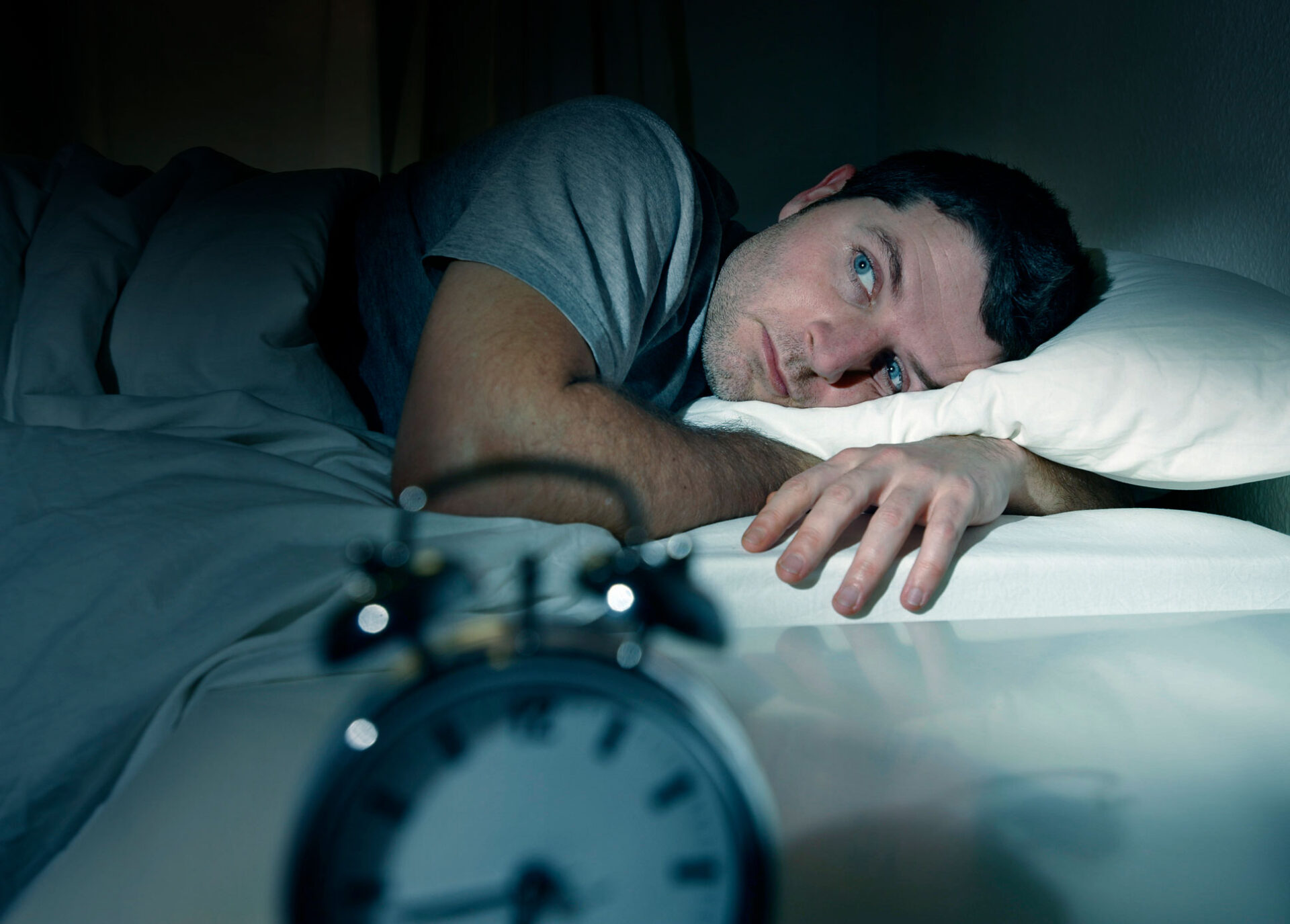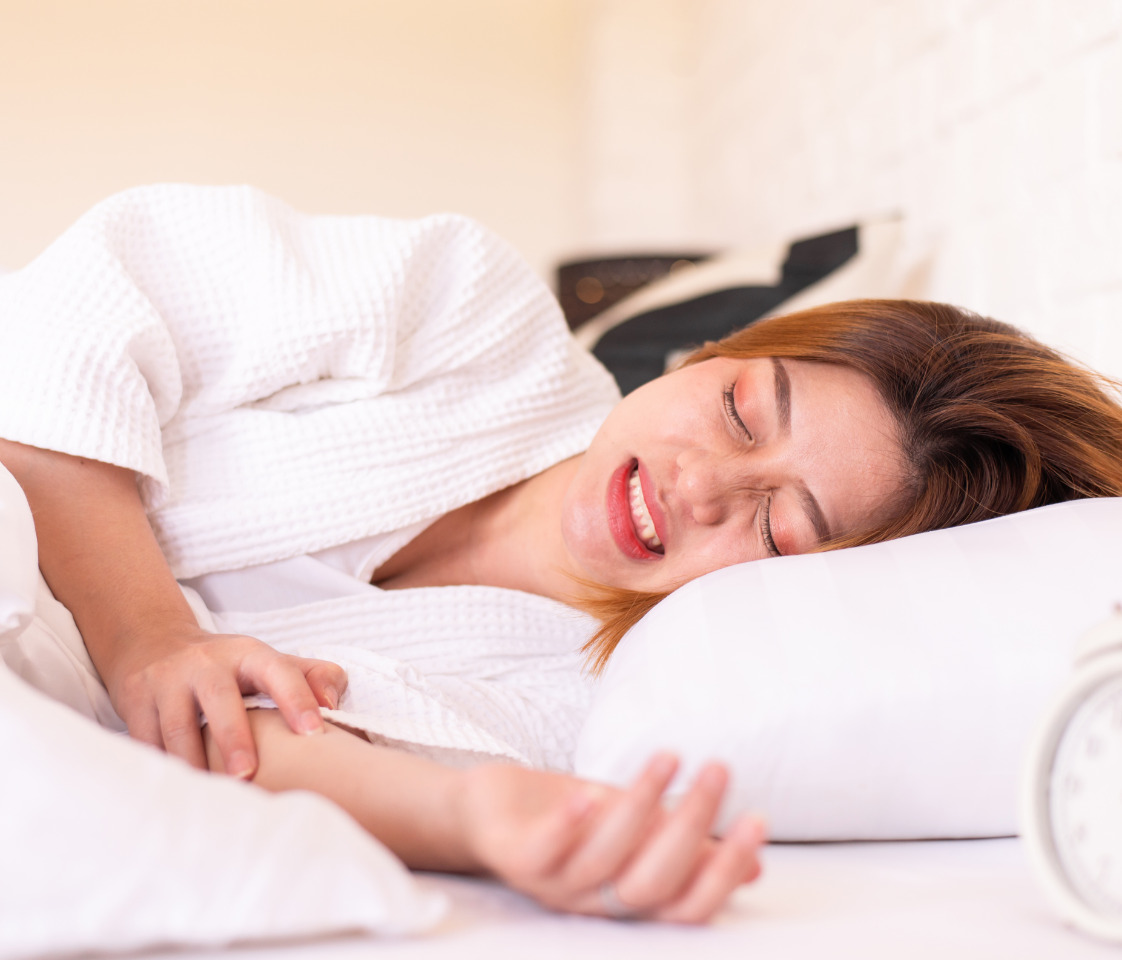Do you wake up every day with a headache or jaw pain, feeling tired like you didn’t get any sleep at all but don’t actually remember waking up? You might be told you have a parasomnia.
Parasomnias are a group of sleep disorders that involve abnormal behaviors or experiences during sleep. From sleepwalking to night terrors, these phenomena can disrupt our sleep cycle (we’ll explain that, too) and leave us feeling restless and fatigued. Is teeth grinding at night one of those disorders?
Let’s answer that question and others to better put into context your possible bruxism symptoms or other parasomnias that might be causing your teeth grinding. We’ll dive into the world of parasomnias, explore the different types, and uncover the mysteries behind sleep bruxism too.
 Parasomnias are a group of disruptive sleep-related disorders characterized by abnormal behaviors, movements, emotions, perceptions, or dreams that occur during sleep or while transitioning between sleep stages. They are distinct from sleep disorders that primarily affect the quantity or quality of sleep, such as insomnia or obstructive sleep apnea. Parasomnias can occur in various stages of sleep, including non-rapid eye movement (NREM) sleep and rapid eye movement (REM) sleep, and typically disrupt the normal sleep cycle.
Parasomnias can manifest in a wide range of behaviors and experiences, including sleepwalking, night terrors, sleep talking, bedwetting, sleep-related eating disorders, sleep-related sexual behavior, and sleep paralysis, sleep bruxism, among others.
Research has frequently found that children are overall more likely to experience parasomnias than adults, with almost 40% of children experiencing some type of parasomnia before age 6.
These episodes can be brief or prolonged, and individuals may have little to no recollection of the events upon waking. Parasomnias can significantly impact sleep quality, lead to daytime drowsiness or fatigue, and may occasionally cause injury to the person experiencing them or those around them. Therefore, diagnosing and managing parasomnias by visiting a sleep doctor is essential to ensure a restful and safe sleep environment.
Parasomnias are a group of disruptive sleep-related disorders characterized by abnormal behaviors, movements, emotions, perceptions, or dreams that occur during sleep or while transitioning between sleep stages. They are distinct from sleep disorders that primarily affect the quantity or quality of sleep, such as insomnia or obstructive sleep apnea. Parasomnias can occur in various stages of sleep, including non-rapid eye movement (NREM) sleep and rapid eye movement (REM) sleep, and typically disrupt the normal sleep cycle.
Parasomnias can manifest in a wide range of behaviors and experiences, including sleepwalking, night terrors, sleep talking, bedwetting, sleep-related eating disorders, sleep-related sexual behavior, and sleep paralysis, sleep bruxism, among others.
Research has frequently found that children are overall more likely to experience parasomnias than adults, with almost 40% of children experiencing some type of parasomnia before age 6.
These episodes can be brief or prolonged, and individuals may have little to no recollection of the events upon waking. Parasomnias can significantly impact sleep quality, lead to daytime drowsiness or fatigue, and may occasionally cause injury to the person experiencing them or those around them. Therefore, diagnosing and managing parasomnias by visiting a sleep doctor is essential to ensure a restful and safe sleep environment.
 The main culprit among parasomnias for any teeth grinding or jaw clenching at night will almost always be sleep bruxism, but there are a few exceptions.
Teeth grinding at night could also occasionally happen in people suffering from REM Sleep Behavior Disorder (RBD), as people react unconsciously to their intense dream activity, leading them to periodic limb movements and teeth grinding sometimes.
It could also be a result of nocturnal seizures, obstructive sleep apnea, or temporomandibular disorder.
The main culprit among parasomnias for any teeth grinding or jaw clenching at night will almost always be sleep bruxism, but there are a few exceptions.
Teeth grinding at night could also occasionally happen in people suffering from REM Sleep Behavior Disorder (RBD), as people react unconsciously to their intense dream activity, leading them to periodic limb movements and teeth grinding sometimes.
It could also be a result of nocturnal seizures, obstructive sleep apnea, or temporomandibular disorder.
 After a sleep study (polysomnography) or sleep doctor has officially diagnosed you with sleep-related bruxism, there are several treatment options that are common for most suffering from this condition.
After a sleep study (polysomnography) or sleep doctor has officially diagnosed you with sleep-related bruxism, there are several treatment options that are common for most suffering from this condition.
Sleep Cycles and Their Importance
First, let’s define a very important concept that we need to learn before explaining what parasomnias are. A sleep cycle is a complex process that consists of 5 stages, usually there are 4 to six cycles per night, Wake/Alert, N1,N2,N3 and REM, each stage has its own unique characteristics and repeat in 80 to 100 minute cycles. The higher the stage of sleep the harder it is to wake the person up. Stage Wake is just like it sounds. It looks like the person is awake but their eyes start to droop and the head starts to nod a bit and they slip into stage N1. Stage N1 sleep is often mistaken for wake. In other words the eyes may still be open, the muscles have tone and breathing is unchanged. Sometimes N1 sleep is referred to as “church sleep” or “seminar sleep”. Generally this stage of sleep lasts from 1 to 5 minutes and makes up about 5% of a full night’s sleep. Stage N2 is where brain waves continue to slow down, and the body temperature and heart rate decrease. The slowing of the brain wave activity is thought to be what helps a person who is asleep stay asleep even when they hear a noise or someone talking. Stage N2 sleep lasts about 25 minutes in the first cycle and lengthens in each successive sleep cycle. N2 usually makes up about 45% of total sleep time. N2 is the stage of sleep when Bruxism occurs. N3 the third stage of sleep, is the deepest stage of sleep and is the hardest stage to wake up from, characterized by slow brain waves, minimal muscle activity, and the release of growth hormones. This stage of sleep diminishes as patients age. It is in stage 3 sleep that the body regrows tissue, builds bone and muscle and strengthens the immune system. Parasomnias that occur in N3 are sleepwalking, night terrors, and bedwetting. While it might seem like the deep sleep state would be the last, that’s not where a good restful sleep ends. After these non-REM sleep stages, the sleep cycle enters the rapid eye movement (REM) stage. During REM sleep, brain activity increases, and vivid dreams commonly occur. This stage is accompanied by rapid eye movements, increased heart rate, and temporary paralysis of the muscles. REM sleep is crucial for cognitive processes, memory consolidation, and emotional regulation, even though it is the shortest-lasting stage, with only 25% of sleep being REM sleep. The sleep cycle typically repeats multiple times throughout the night, with each cycle lasting about 90 minutes and the duration of REM sleep increasing with each subsequent cycle. In total, a good night should include up to 7 hours of sleep, although that will vary slightly from person to person. Not going through a normal amount of these cycles leads to sleep deprivation and many serious consequences, like daytime sleepiness, unusual behaviors, memory loss, stress, anxiety, and many other conditions.What is a Parasomnia?
 Parasomnias are a group of disruptive sleep-related disorders characterized by abnormal behaviors, movements, emotions, perceptions, or dreams that occur during sleep or while transitioning between sleep stages. They are distinct from sleep disorders that primarily affect the quantity or quality of sleep, such as insomnia or obstructive sleep apnea. Parasomnias can occur in various stages of sleep, including non-rapid eye movement (NREM) sleep and rapid eye movement (REM) sleep, and typically disrupt the normal sleep cycle.
Parasomnias can manifest in a wide range of behaviors and experiences, including sleepwalking, night terrors, sleep talking, bedwetting, sleep-related eating disorders, sleep-related sexual behavior, and sleep paralysis, sleep bruxism, among others.
Research has frequently found that children are overall more likely to experience parasomnias than adults, with almost 40% of children experiencing some type of parasomnia before age 6.
These episodes can be brief or prolonged, and individuals may have little to no recollection of the events upon waking. Parasomnias can significantly impact sleep quality, lead to daytime drowsiness or fatigue, and may occasionally cause injury to the person experiencing them or those around them. Therefore, diagnosing and managing parasomnias by visiting a sleep doctor is essential to ensure a restful and safe sleep environment.
Parasomnias are a group of disruptive sleep-related disorders characterized by abnormal behaviors, movements, emotions, perceptions, or dreams that occur during sleep or while transitioning between sleep stages. They are distinct from sleep disorders that primarily affect the quantity or quality of sleep, such as insomnia or obstructive sleep apnea. Parasomnias can occur in various stages of sleep, including non-rapid eye movement (NREM) sleep and rapid eye movement (REM) sleep, and typically disrupt the normal sleep cycle.
Parasomnias can manifest in a wide range of behaviors and experiences, including sleepwalking, night terrors, sleep talking, bedwetting, sleep-related eating disorders, sleep-related sexual behavior, and sleep paralysis, sleep bruxism, among others.
Research has frequently found that children are overall more likely to experience parasomnias than adults, with almost 40% of children experiencing some type of parasomnia before age 6.
These episodes can be brief or prolonged, and individuals may have little to no recollection of the events upon waking. Parasomnias can significantly impact sleep quality, lead to daytime drowsiness or fatigue, and may occasionally cause injury to the person experiencing them or those around them. Therefore, diagnosing and managing parasomnias by visiting a sleep doctor is essential to ensure a restful and safe sleep environment.
Types of Parasomnia
The list of parasomnias is a very varied set of disorders that have, with one exception, one thing in common—sufferers rarely remember any of this and mostly find out because of the symptoms or signs the morning after. These are micro-arousals from sleep, not complete arousals in the middle of the night. Here are the most common or known parasomnias:1. Sleep Bruxism
This parasomnia involves the involuntary grinding or clenching of teeth during sleep, also called Rhythmic Masticatory Muscle Activity (RMMA), which often leads to dental problems, sore jaw muscles, headaches, ear pain, and temporomandibular joint disorder. Some research has also linked sleep bruxism to obstructive sleep apnea. Rhythmic Masticatory Muscle Activity and sleep bruxism are not interchangeable terms, as one can appear without the other, but it should be noted that one study from 2016 found that RMMA was three times more common and about 30% more intense in patients with sleep-related bruxism than with other parasomnias.2. Sleepwalking (Somnambulism)
Sleepwalkers engage in complex activities during sleep like walking, talking, and eating, often with no memory of the events, and the only reason they even realize something is wrong is that their sleep partner alerts them to it, video from home security cameras, or moved objects the next morning.3. Night Terrors (Sleep Terrors)
Night terrors are characterized by sudden episodes of intense fear, screaming, and physical agitation during sleep. Individuals may appear to be awake but are not fully conscious.4. Confusional Arousals
This parasomnia involves acting confused or disoriented upon awakening from sleep, often with no recollection of the episode.5. Rapid Eye Movement or REM Sleep Behavior Disorder
In this disorder, individuals physically act out vivid and often violent dreams during REM sleep, sometimes resulting in injuries to themselves or bed partners with lateral movements, arm and leg movements, or jumping up and down.6. Sleep-Related Eating Disorder
(SRED) Individuals with SRED consume food while asleep, often leading to overeating, unusual food combinations, and potential health concerns.7. Sleep Paralysis
Sleep paralysis occurs when a person is temporarily unable to move or speak when falling asleep or waking up. It can be accompanied by vivid hallucinations.8. Exploding Head Syndrome
This parasomnia is characterized by sudden loud noises, such as explosions or crashes, just as a person is falling asleep or waking up.9. Nocturnal Enuresis (Bedwetting)
Bedwetting during sleep is a parasomnia that is more common in children and can persist into adulthood in some cases.10. Sleep-Related Groaning (Catathrenia)
Catathrenia involves the emission of moaning or groaning sounds during expiration while sleeping. It is often accompanied by breath-holding. It can be a very disturbing experience for that person’s sleep partner.11. Sleep-Related Hallucinations
Some people experience vivid and often frightening hallucinations while falling asleep or waking up. These can be visual, auditory, or tactile, causing their sleep quality to suffer.12. Sleep Talking (Somniloquy)
Sleep talking involves talking or making sounds during sleep without the person being aware of it.13. Sleep-Related Movement Disorders
These disorders include periodic limb movement disorder (PLMD) and restless leg syndrome (RLS), characterized by repetitive, involuntary body movements and limb movements or sensations during sleep, but not necessarily because they’re acting out dreams.14. Rhythmic Movement Disorder (RMD)
Rhythmic Movement Disorder (RMD) is a neurological disorder characterized by repetitive and stereotyped movements performed during sleep or while awake. These movements typically involve rocking, headbanging, or body rolling. RMD is most commonly observed in infants and young children, but it can also affect adults. The disorder often occurs during periods of relaxation or drowsiness and can interfere with normal sleep patterns. These parasomnias can vary in severity and frequency, and they may occur at different stages of sleep. Some may be benign and require no treatment, while others can be more disruptive and necessitate medical or behavioral interventions.Possible Causes of Parasomnias
There are various possible causes for these conditions that induce abnormal behaviors during sleep. One possible cause is genetic factors. Studies have shown that certain parasomnias, such as sleepwalking and night terrors, tend to run in families. For example, a 2012 review of several genetic studies found that a specific genetic variant was associated with an increased risk of sleepwalking and many other sleep disorders. This suggests that genetic factors may play a role in the development of parasomnias. Another possible cause of parasomnias is sleep deprivation or disrupted sleep. Lack of quality sleep or irregular sleep patterns can increase the likelihood of experiencing parasomnias. Sleep deprivation, insomnia, and other sleep-related disorders have been found to be significantly associated with an increased risk of parasomnias. This highlights the importance of maintaining good sleep hygiene and addressing any underlying sleep disorders to reduce the occurrence of parasomnias.Sleep Disorders or Parasomnias Associated with Teeth Grinding
 The main culprit among parasomnias for any teeth grinding or jaw clenching at night will almost always be sleep bruxism, but there are a few exceptions.
Teeth grinding at night could also occasionally happen in people suffering from REM Sleep Behavior Disorder (RBD), as people react unconsciously to their intense dream activity, leading them to periodic limb movements and teeth grinding sometimes.
It could also be a result of nocturnal seizures, obstructive sleep apnea, or temporomandibular disorder.
The main culprit among parasomnias for any teeth grinding or jaw clenching at night will almost always be sleep bruxism, but there are a few exceptions.
Teeth grinding at night could also occasionally happen in people suffering from REM Sleep Behavior Disorder (RBD), as people react unconsciously to their intense dream activity, leading them to periodic limb movements and teeth grinding sometimes.
It could also be a result of nocturnal seizures, obstructive sleep apnea, or temporomandibular disorder.
Sleep-Related Bruxism or Teeth Grinding at Night
As already mentioned in our list of parasomnias, bruxism at night or sleep-related bruxism is a condition characterized by involuntary grinding, clenching, or gnashing of teeth during sleep. It is a common sleep disorder that can lead to various dental and oral health problems over time, although it tends to be more common in children. Nonetheless, one study from 2016 found that about 13% of adults suffer from frequent sleep-related bruxism, with most episodes of bruxism occurring in the first hour of sleep during the light stages of non-REM. Among the clear signs and symptoms of sleep bruxism are waking up to morning jaw muscle pain, feeling tired, having morning headaches or earaches, long-term tooth wear and tear, lockjaw, damaged gums, and even lesions on the inside of your cheek.Risk Factors for Teeth Grinding at Night
One of the primary risk factors is stress and anxiety. Individuals who experience high levels of stress or anxiety are more likely to grind their teeth during sleep. Additionally, certain personality traits like aggression and competitiveness may also contribute to the development of sleep bruxism. Another significant risk factor for sleep bruxism is sleep disorders. Individuals who suffer from sleep apnea, insomnia, or other sleep-related disorders are more prone to teeth grinding during sleep. The disruption in sleep patterns and the inability to achieve deep, restful sleep can lead to increased muscle activity, including grinding of the teeth. There are also certain medications, such as antidepressants and stimulants, which can increase the risk of sleep bruxism. It is crucial to identify and address these risk factors to effectively manage and treat sleep bruxism.Treatment Options for Sleep Bruxism
 After a sleep study (polysomnography) or sleep doctor has officially diagnosed you with sleep-related bruxism, there are several treatment options that are common for most suffering from this condition.
After a sleep study (polysomnography) or sleep doctor has officially diagnosed you with sleep-related bruxism, there are several treatment options that are common for most suffering from this condition.

